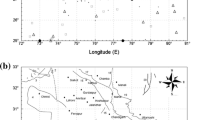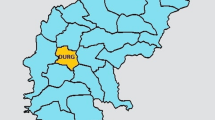Abstract
Amaravati is the proposed capital city of Andhra Pradesh, India. Considering the critical structures and infrastructure systems to be built in the near future, the proposed capital city needs a seismic investigation. In the present study, an attempt was made to quantify the seismic hazard of Amaravati city (Latitude 16° 24′ 36″ N to 16° 35′ 24″ N and Longitude 80° 24′ 25″ E to 80° 36′ 18″ E), India, using a deterministic framework. The seismotectonic map is prepared by considering the seismic events of the moment magnitude MW ≥ 3.5 for the period 1800–2021. The seismic hazard of the Amaravati city is presented in the form of spatial variation of peak ground acceleration (PGA) at bedrock level for four scenarios. It is found that the maximum PGA values obtained for all four scenarios, i.e., 0.227 g, 0.414 g, 0.188 g, and 0.278 g, are higher than the values recommended by IS 1893-Part I (IS 1893 (Criteria for earthquake-resistant design of structures, part 1: general provisions and buildings). Bureau of Indian Standards, New Delhi, 2016). The spatial variation of 50th and 84th percentile spectral accelerations at short and long periods shows the high seismic hazard at southeastern part of Amaravati. The deterministic response spectra are developed for six important regions of Amaravati city. The study's findings will be very useful for the earthquake-resistant design of upcoming civil engineering structures in Amaravati city.











Similar content being viewed by others
Data Availability
Some or all data, models or code used during the study was provided by a third party. Direct requests for these materials may be made to the provider as indicated in the Acknowledgements.
References
Abrahamson N, Silva W (2008) Summary of the Abrahamson & Silva NGA ground-motion relations. Earthq Spectra 24(1):67–97
Akkar S, Sandıkkaya MA, Bommer JJ (2013) Empirical ground-motion models for point- and extended-source crustal earthquake Scenarios in Europe and the Middle East. Bull Earthq Eng 12(1):359–387
Anbazhagan P, Bajaj K, Dutta N, Sayed S, Moustafa R, Nassir S, Al-Arifi N (2017) Region-specific deterministic and probabilistic seismic hazard analysis of Kanpur city. J Earth Syst Sci 126(1):1–21
Anbazhagan P, Bajaj K, Patel S (2015) Seismic hazard maps and spectrum for Patna considering region-specific seismotectonic parameters. Natural Hazards, vol 78. Springer, Netherlands
Anbazhagan P, Gajawada P, Parihar A (2012) Seismic hazard map of Coimbatore using subsurface fault rupture. Nat Hazards 60:1325–1345
ArcGIS (10.7.1). 2020. Environmental Systems Research Institute (ESRI), Redlands, CA
Atkinson GM (2008) Ground-motion prediction equations for Eastern North America from a referenced empirical approach: implications for epistemic uncertainty. Bull Seismol Soc Am 98(3):1304–1318
Atkinson GM (2015) Ground‐motion prediction equation for small‐to‐moderate events at short hypocentral distances, with application to induced‐seismicity hazards. Bull Seismol Soc Am 105(2A):981–992
Bonilla MG, Mark RK, Lienkemper JJ (1984) Statistical relations among earthqukae magnitude, surface rupture length, and surface fault displacement. Bull Seismol Soc Am 74(6):2379–2411
Boominathan A, Dodagoudar GR, Suganthi A, Maheswari RU (2008) Seismic hazard assessment of chennai city considering local site effects. J Earth Syst Sci 117(SUPPL.2):853–863
Campbell KW, Bozorgnia Y (2008) NGA ground motion model for the geometric mean horizontal component of PGA, PGV, PGD and 5% damped linear elastic response spectra for periods ranging from 0.01 to 10 S. Earthq Spectra 24(1):139–171
Census (2011) Primary Census Abstracts, Registrar General of India, Ministry of Home Affairs, Government of India. http://www.censu sindia.gov.in
Costa G, Panza GF, Suhadolc P, Vaccari F (1993) Zoning of the Italian territory in terms of expected peak ground acceleration derived from complete synthetic seismograms. J Appl Geophys 30(1–2):149–160
Cramer CH, Kumar A (2003) 2001 Bhuj, India, earthquake engineering seismoscope recordings and Eastern North America ground-motion attenuation relations. Bull Seismol Soc Am 93(3):1390–1394
Choudhury D, Shukla J (2011) Probability of occurrence and study of earthquake recurrence models for Gujarat state in India. Disaster Adv 4(2):47–59
Desai S, Choudhury D (2014) Deterministic seismic hazard analysis for Greater Mumbai, India. In: Geo-congress 2014: geo-characterization and modeling for sustainability, pp 389–398
Goodess C, Harpham C, Kent N, Urlam R, Chaudhary S, Dholakia HH (2019) Amaravati building climate resilience. Mott Macdonald Report, CEEW-University of East Anglia
Gutenberg B, Richter CF (1944) Frequency of earthquakes in California. Bull Seismol Soc Am 34:185–188
Hwang H, Huo JR (1997) Attenuation relations of ground motion for rock and soil sites in Eastern United States. Soil Dyn Earthq Eng 16(6):363–372
IS 1893 (Part 1) (2016) IS 1893 (Criteria for earthquake resistant design of structures, part 1: general provisions and buildings). Bureau of Indian Standards, New Delhi, pp 1–4
Kataria NP, Shrikhande M, Das JD (2013) Deterministic seismic hazard analysis of Andaman and Nicobar Islands. J Earthq Tsunami 7(4):1350035
Kolathayar S, Sitharam TG, Vipin KS (2012) Deterministic seismic hazard macrozonation of India. J Earth Syst Sci 121(5):1351–1364
Kramer SL (1996) Geotechnical earthquake engineering. Pearson Education India
Mark RK (1977) Application of linear statistical models of earthquake magnitude versus fault length in estimating maximum expectable earthquakes. Geology 5(8):464–466
Mase LZ (2020) Seismic hazard vulnerability of Bengkulu city, Indonesia, based on deterministic seismic hazard analysis. Geotech Geol Eng 38(5):5433–5455
Mehta P, Thaker TP (2020) Seismic hazard analysis of Vadodara region, Gujarat, India: probabilistic and deterministic approach. J Earthq Eng 26(3):1438–1460
Moratto L, Orlecka-Sikora B, Costa G, Suhadolc P, Papaioannou CH, Papazachos CB (2007) A deterministic seismic hazard analysis for shallow earthquakes in Greece. Tectonophysics 442(1–4):66–82
Naik N, Choudhury D (2015) Deterministic seismic hazard analysis considering different seismicity levels for the state of Goa, India. Nat Hazards 75(1):557–580
National Disaster Management Authority (NDMA) (2011) Development of Probabilistic Seismic Hazard Map of India. Govt. of India
Nowroozi A (1985) Empirical relations between magnitudes and fault parameters for earthquakes in IRAN. Bull Seismol Soc Am 75(5):1327–1338
Parvez IA, Magrin A, Vaccari F, Mir RR, Peresan A, Panza GF (2017) Neo-deterministic seismic hazard Scenarios for India—a preventive tool for disaster mitigation. J Seismol 21:1559–1575
Parvez IA, Vaccari F, Panza GF (2003) A deterministic seismic hazard map of India and adjacent areas. Geophys J Int 155(2):489–508
Ramaswamy A, Murty M (1973) The charnockite series of Amaravathi, Gunter District, Andhra Pradesh, South India. Geol Mag 110(2):171–184
Ramkrishnan R, Kolathayar S, Sitharam TG (2021) Seismic hazard assessment and land use analysis of Mangalore city, Karnataka, India. J Earthq Eng 25(12):2349–2370. https://doi.org/10.1080/13632469.2019.1608333
Rao VD, Chodhury D (2018) Prediction of earthquake occurrence for a new nuclear power plant in India using probabilistic models. Innovative Infrastruct Solutions 3:79
Rao VD, Chodhury D (2020) Probabilistic modelling for earthquake forecasting in the Northwestern part of Haryana state, India. Pure Appl Geophys 177:3073–3087
Rao VD, Choudhury D (2021) Deterministic seismic hazard analysis for the Northwestern part of Haryana state, India, considering various seismicity levels. Pure Appl Geophys 178(2):449–464
Satyannarayana R, Rajesh BG (2021) Seismotectonic map and seismicity parameters for Amaravati area, India. Arab J Geosci 14:22
Sitharam TG, Anbazhagan P (2007) Seismic hazard analysis for the Bangalore region. Nat Hazards 40(2):261–278
Stepp JC (1972) Analysis of completeness of the earthquake sample in the puget sound area and its effect on statistical estimates of earthquake hazard. In: International conference on microzonification, pp 897–910
Toro GR (2002) Modification of the Toro et al. (1997) attenuation equations for large magnitudes and short distances. Risk Eng Techn Rep No. 1997: 1–10
Wang JP, Taheri H (2014) Seismic hazard assessment of the Tehran Region. Nat Hazard Rev 15(2):121–127
Wells DL, Coppersmith KJ (1994) Updated empirical relationships among magnitude, rupture length, rupture area and surface displacement. Bull Seismol Soc Am 84:4–43
Acknowledgements
The authors wish to express their sincere thanks for the financial support of the Science and Engineering Research Board, Department of Science and Technology, Government of India (SRG/2019/001810). The authors would also like to thank National Earthquake Information Centre (NEIC), United States Geological Survey (USGS), Advanced National Seismic System (ANSS) and International Seismological Centre (ISC) for providing the details of earthquake events in the study area. The authors extend their thanks to Dr. Sreevalsa Kolathayar (Assistant Professor, National Institute of Technology Karnataka, Surathkal) for his valuable inputs in this study.
Funding
This work was supported by the Science and Engineering Research Board, Department of Science and Technology, Government of India (SRG/2019/001810). The second author Dr. B. Giridhar Rajesh is the recipient of the grant.
Author information
Authors and Affiliations
Contributions
All authors contributed to the study conception and design. Material preparation, data collection and analysis were performed by Rambha Satyannarayana and Dr. B. Giridhar Rajesh. The first draft of the manuscript was written by Rambha Satyannarayana. The first draft was improved by making considerable modifications by Dr. B. Giridhar Rajesh. Both the authors read and approved the final manuscript.
Corresponding author
Ethics declarations
Conflict of interest
The authors have no relevant financial or nonfinancial interests to disclose. The authors declare that there is no conflict of interest.
Additional information
Publisher's Note
Springer Nature remains neutral with regard to jurisdictional claims in published maps and institutional affiliations.
Rights and permissions
Springer Nature or its licensor (e.g. a society or other partner) holds exclusive rights to this article under a publishing agreement with the author(s) or other rightsholder(s); author self-archiving of the accepted manuscript version of this article is solely governed by the terms of such publishing agreement and applicable law.
About this article
Cite this article
Satyannarayana, R., Rajesh, B.G. Estimation of Seismic Ground Motions Using Deterministic Seismic Hazard Analysis for Amaravati City, India. Indian Geotech J (2023). https://doi.org/10.1007/s40098-023-00801-9
Received:
Accepted:
Published:
DOI: https://doi.org/10.1007/s40098-023-00801-9




